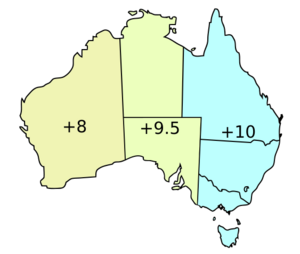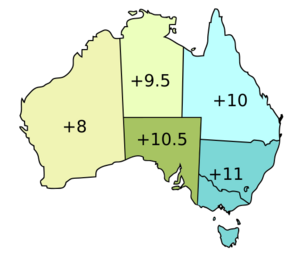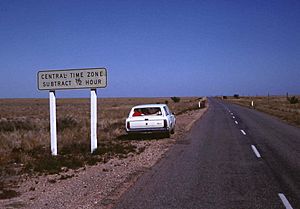Time in Australia facts for kids
Australia is a huge country, so it uses three main time zones to keep track of time! These are:
- Australian Eastern Standard Time (AEST), which is 10 hours ahead of Coordinated Universal Time (UTC+10:00).
- Australian Central Standard Time (ACST), which is 9 hours and 30 minutes ahead of UTC (UTC+09:30).
- Australian Western Standard Time (AWST), which is 8 hours ahead of UTC (UTC+08:00).
Each Australian state government decides its own time. Some states also use Daylight saving time (DST). This means they move their clocks forward by one hour during warmer months. DST usually runs from the first Sunday in October to the first Sunday in April.
States that use DST are:
- New South Wales, Victoria, Tasmania, Jervis Bay Territory, and the Australian Capital Territory. They switch to Australian Eastern Daylight Saving Time (AEDT; UTC+11:00).
- South Australia switches to Australian Central Daylight Saving Time (ACDT; UTC+10:30).
Standard time was first used in Australia in the 1890s. Before this, each town set its own time! Now, Western Australia uses Western Standard Time. South Australia and the Northern Territory use Central Standard Time. New South Wales, Queensland, Tasmania, Victoria, Jervis Bay Territory, and the Australian Capital Territory use Eastern Standard Time.
Currently, Western Australia, the Northern Territory, and Queensland do not use daylight saving time.
Australia also has some smaller islands that use different time zones:
- The Cocos (Keeling) Islands use UTC+06:30 all year.
- Christmas Island uses UTC+07:00 all year.
- Norfolk Island uses UTC+11:00 as standard time and UTC+12:00 during daylight saving time.
Contents
History of Time in Australia
The idea of standard time zones in Australia started in 1892. Surveyors from the six Australian colonies met in Melbourne. They decided to use Greenwich Mean Time (GMT) as the base for Australia's time.
The colonies then made laws for time zones, which began in February 1895.
- Western Australia set its clocks 8 hours ahead of GMT.
- South Australia (and the Northern Territory, which it controlled) set clocks 9 hours ahead.
- Queensland, New South Wales, Victoria, and Tasmania set clocks 10 hours ahead.
These became known as Western, Central, and Eastern Standard Time.
Interestingly, Broken Hill in New South Wales used Central Standard Time. This was because it was connected by train to Adelaide in South Australia, not Sydney.
In 1899, South Australia changed its Central Standard Time. They moved it forward by 30 minutes. This made it 9 hours and 30 minutes ahead of GMT. Businesses wanted to be closer to Melbourne's time. Also, sports players wanted more daylight for evening practice. This change meant South Australia's time zone was a bit unusual compared to other places in the world.
In 1911, the Northern Territory became separate from South Australia. It kept Central Standard Time. The Australian Capital Territory (ACT) and Jervis Bay Territory also kept Eastern Standard Time when they separated from New South Wales.
Since 1899, there haven't been many big changes. Lord Howe Island now uses GMT plus 10:30. Norfolk Island changed from UTC+11:30 to UTC+11:00 in 2015.
How Time is Set by Law
The governments of Australian states and territories can make laws about time. However, the official standard time is linked to Coordinated Universal Time (UTC). This is set by an international group called the International Bureau of Weights and Measures. Australia's National Measurement Act of 1960 also helps set this.
Since the 1990s, Australia has used a version of UTC. Before 2005, GMT was the official basis for time. But in 2005, all Australian states and territories agreed to use UTC. This made timekeeping more accurate.
For daylight saving time, states like Victoria, South Australia, Tasmania, and the ACT decide when it starts and ends. This is usually done by official announcements. In New South Wales and Western Australia, these dates are set by law.
Australian Western Standard Time (AWST) – UTC+08:00
- Western Australia uses this time.
Australian Central Standard Time (ACST) – UTC+09:30
- South Australia uses this time.
- The Northern Territory uses this time.
Australian Western Central Standard Time (AWCST) UTC+8:45
- A small part of southeastern Western Australia uses this.
- Towns like Border Village, Eucla, Mundrabilla, Madura, and Cocklebiddy use this special time.
Australian Eastern Standard Time (AEST) – UTC+10:00
- Queensland uses this time.
- New South Wales uses this time.
- The Australian Capital Territory and Jervis Bay Territory use this time.
- Victoria uses this time.
- Tasmania uses this time.
Daylight Saving Time (DST) in Detail
Each state and territory decides if it wants to use DST. During World War I and World War II, all states used DST. In 1968, Tasmania was the first state to use DST again in peacetime. Then, in 1971, New South Wales, Victoria, Queensland, South Australia, and the Australian Capital Territory followed.
Queensland stopped using DST in 1972. Western Australia and the Northern Territory never adopted it. Queensland and Western Australia have tried using DST for short periods since then.
The main DST zones are:
- (Australian) Central Daylight Saving Time (ACDT) – UTC+10:30. This is used in South Australia and Broken Hill, New South Wales.
- (Australian) Eastern Daylight Saving Time (AEDT) – UTC+11:00. This is used in New South Wales, the ACT, Victoria, and Tasmania.
When DST is in effect, Australia has five time zones instead of three. This is because Western Australia (UTC+08:00), the Northern Territory (UTC+09:30), and Queensland (UTC+10:00) do not change their clocks.
Clocks change for DST at 2:00 AM local standard time on the correct Sunday. Before 2008, DST usually started on the last Sunday in October and ended on the last Sunday in March. Tasmania, being further south, started earlier (first Sunday in October) and ended later (first Sunday in April).
In 2007, New South Wales, Victoria, Tasmania, and the ACT agreed to have the same DST dates from 2008. DST in these states and South Australia now starts on the first Sunday in October and ends on the first Sunday in April. Western Australia used DST from the last Sunday in October to the last Sunday in March for a while, but they stopped using it in 2009.
| State/territory | Start of DST | End of DST |
|---|---|---|
| Western Australia |
|
|
| Queensland | ||
| Northern Territory | ||
| South Australia | First Sunday in October | First Sunday in April |
| New South Wales | ||
| Australian Capital Territory | ||
| Jervis Bay Territory | ||
| Victoria | ||
| Tasmania | ||
Time Zone Quirks
Some towns near state borders use a different time zone than the rest of their state.
- Broken Hill and the area around it in New South Wales use Australian Central Standard Time (UTC+09:30). This is the same time zone as nearby South Australia and the Northern Territory.
Heron Island, off the coast of Queensland, has two time zones! The island resort uses DST all year, but the Marine Research Centre and Parks and Wildlife office stay on Eastern Standard Time. No one is quite sure how this started, but it might have been to give guests more daylight.
Lord Howe Island, which is part of New South Wales but far out in the Pacific Ocean, uses UTC+10:30 in winter. This is 30 minutes ahead of the eastern states. In summer, it moves to UTC+11:00, which is the same as the rest of New South Wales during DST.
A special time zone, UTC+08:45, is used in a small area in the southeastern corner of Western Australia. It's sometimes called Central Western Standard Time. Towns like Eucla, Cocklebiddy, Madura, Mundrabilla, and Border Village (just over the border in South Australia) use this time. This area has about 200 people. This unofficial time zone is even marked by road signs!
Some small towns in Outback Western Australia also use UTC+09:30 instead of UTC+08:00. These include Blackstone, Irrunytju, Warakurna, Wanarn, Kiwirrkurra, and Tjukurla.
The Indian Pacific train sometimes has its own "train time" when traveling between Kalgoorlie, Western Australia, and Port Augusta, South Australia.
Time in External Territories
Australia's external territories (islands far away from the mainland) have their own time zones:
| Territory | Standard Time | Daylight Saving Time |
|---|---|---|
| Heard and McDonald Islands | UTC+05:00 | No DST |
| Cocos (Keeling) Islands | UTC+06:30 | No DST |
| Christmas Island | UTC+07:00 | No DST |
| Norfolk Island | UTC+11:00 | UTC+12:00 |
| Australian Antarctic Territory – Mawson | UTC+05:00 | No DST |
| Australian Antarctic Territory – Davis | UTC+07:00 | No DST |
| Australian Antarctic Territory – Casey | UTC+08:00 | No DST |
Special Time Events
Sometimes, time changes for special events:
- In 2000, for the 2000 Summer Olympics in Sydney, eastern states like New South Wales, Victoria, the ACT, and Tasmania started DST early, on August 27, 2000. South Australia waited until the usual date.
- In 2006, for the 2006 Commonwealth Games in Melbourne, all states that used DST delayed ending it by one week. DST ended on April 2, 2006.
National Times for Business
Sometimes, a single time is used across Australia for business. For example, when selling company shares, a deadline might be set for Sydney time. This means offers must be received by that time, no matter where they come from. The Australian Securities Exchange also uses Eastern Standard Time.
However, for many other things, like working hours for government employees or public holidays, federal laws follow the local state times. For federal elections, polls in Western Australia close two or three hours after those in the eastern states. This means people in Western Australia can vote later in the day.
Debates About Daylight Saving Time
Queensland's DST Debate
Queensland has had many discussions about daylight saving time. People in different parts of the state have different opinions.
- Queensland tried DST from 1971 to 1972. A study after this trial suggested not to adopt DST. Reasons included Queensland's geography and a lack of support.
- Another trial ran from 1989 to 1992. After this, a vote (referendum) was held in 1992. People voted against DST, with 54.5% saying no. People in northern and western Queensland were mostly against it, while those in the southeast (like Brisbane) were more in favor.
- Some islands, like Hayman and Lindeman, even kept using DST for a while against the law, but they stopped in 1995. Heron Island still has its own special time rules.
- Since the late 1900s, many people have asked the Queensland government to bring back DST or hold another vote. In 2006, over 62,000 people signed a petition.
- In 2007, a report showed that 59% of Queenslanders and 69% in southeastern Queensland wanted DST. But the Premier, Anna Bligh, decided not to hold a new vote because people in rural Queensland were strongly against it.
- A political party called "Daylight Saving for South East Queensland" was formed in 2008. They wanted a system where only southeastern Queensland used DST. They ran in the 2009 state election.
- In 2010, a bill was put forward to hold a vote on DST for southeastern Queensland. The government asked the public what they thought. Over 74,000 people responded. Most wanted a trial or a vote. But the Premier again said no, because rural Queenslanders were still against it. The bill was defeated in 2011.
Western Australia's DST Debate
Western Australia has also had many debates about DST. They have voted on it four times: in 1975, 1984, 1992, and 2009. Each time, people voted against adopting DST.
- The 2009 vote had the highest "no" percentage, with 54.6% against it.
- Each vote happened after a trial period where the state used DST. The first three trials lasted one year. The last trial, from 2006 to 2009, lasted three years.
Deviances
Some towns near state borders use a different time zone than the rest of their own state. They might follow the time zone of the neighboring state instead.
- Broken Hill in New South Wales uses the same time zone as South Australia all year.
- Many towns in Western Australia, like Blackstone and Kiwirrkurra, use Central Standard Time instead of Western Standard Time.
- The Gold Coast Airport is on the border of New South Wales and Queensland. It uses Australian Eastern Standard Time (AEST) all year. This is even though New South Wales uses daylight saving time and Queensland does not.
| Town | State/territory | Time zone | Reference(s) |
|---|---|---|---|
| Blackstone | Central | ||
| Border Village | Central Western | ||
| Broken Hill | Central (DST) | ||
| Caiguna | Central Western | ||
| Cocklebiddy | Central Western | ||
| Eucla | Central Western | ||
| Kiwirrkurra | Central | ||
| Madura | Central Western | ||
| Mundrabilla | Central Western | ||
| Silverton | Central (DST) | ||
| Tjukurla | Central | ||
| Warakurna | Central | ||
| Wingellina | Central |
See also
 In Spanish: Husos horarios de Australia para niños
In Spanish: Husos horarios de Australia para niños






